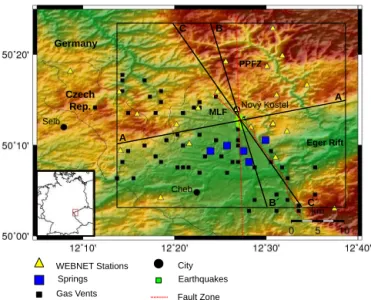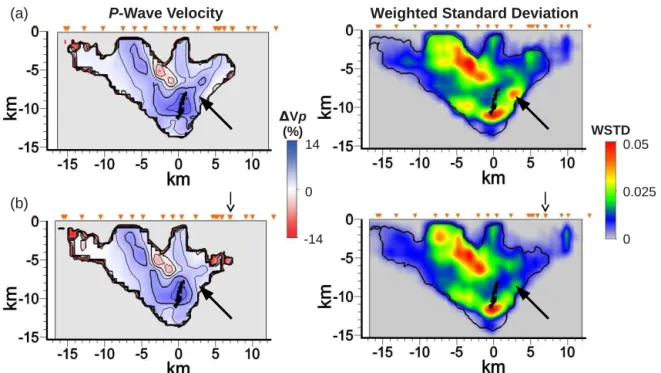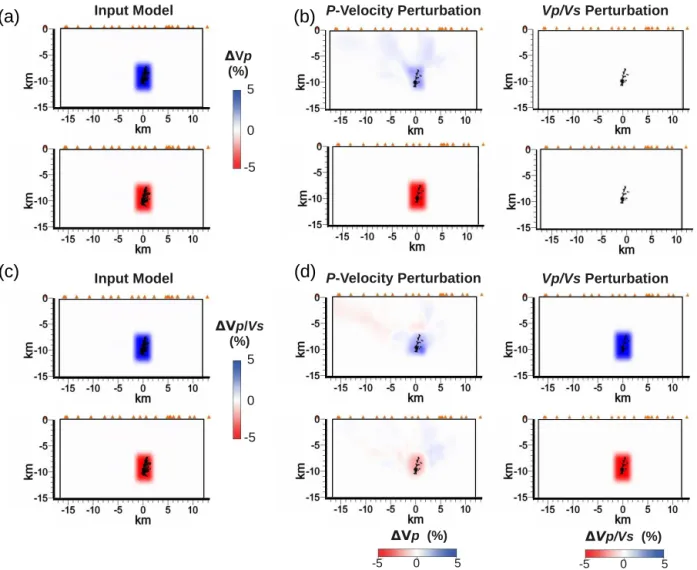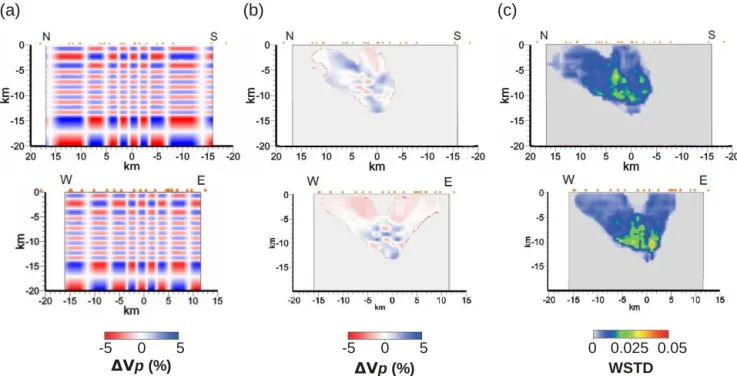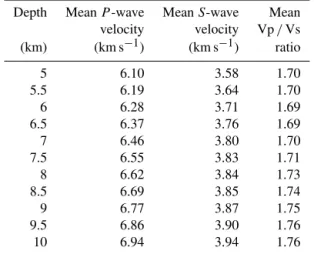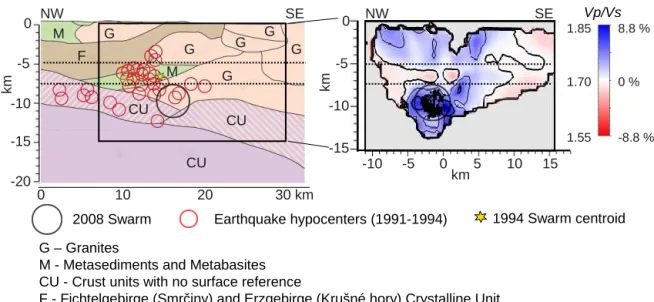www.solid-earth.net/5/863/2014/ doi:10.5194/se-5-863-2014
© Author(s) 2014. CC Attribution 3.0 License.
Velocity structure and the role of fluids in the
West Bohemia Seismic Zone
C. Alexandrakis1, M. Calò2, F. Bouchaala3, and V. Vavryˇcuk4
1Institute of Geophysics and Geoinformatics, TU Bergakademie Freiberg, Freiberg, Germany 2Berkeley Seismological Laboratory, Berkeley, USA
3The Petroleum Institute, Abu Dhabi, United Arabic Emirates
4Institute of Geophysics, Czech Academy of Science, Prague, Czech Republic
Correspondence to:C. Alexandrakis (catherine.alexandrakis@geophysik.tu-freiberg.de) Received: 27 January 2014 – Published in Solid Earth Discuss.: 11 February 2014 Revised: 14 July 2014 – Accepted: 15 July 2014 – Published: 27 August 2014
Abstract. In this study, we apply the double-difference to-mography to investigate the detailed 3-D structure within and around the Nový Kostel Seismic Zone, an area in the Czech Republic known for frequent occurrences of earth-quake swarms. We use data from the 2008 swarm since it has already been analysed in terms of earthquake focal mechanisms, principal faults, tectonic stress and foci migra-tion. We selected about 500 microearthquakes recorded at 22 local seismic stations of the West Bohemia seismic moni-toring network (WEBNET). Applying double-difference to-mography, combined with weighted average model (WAM) post-processing to correct for parameter dependence effects, we produce and interpret 3-D models of the Vp-to-Vs ra-tio (Vp/Vs) in and around the focal zone. The modelled Vp/Vs ratio shows several distinct structures, namely an area of high Vp/Vs ratio correlating with the foci of the mi-croearthquakes, and a layer of low values directly above it. These structures may reflect changes in lithology and/or fluid concentration. The overlaying low Vp/Vs ratio layer coin-cides with the base of the Fichtelgebirge (Smrˇciny) granitic intrusion. It is possible that the base of the layer acts as a fluid trap and an upper limit to the seismicity, resulting in observed periodic swarms.
1 Introduction
The Nový Kostel Seismic Zone is the most seismically ac-tive area in West Bohemia (Czech Republic), a region known for frequent earthquake swarms (Fig. 1). Isotope analysis
(mainly He3/He4) indicates that the fluids released from gas vents and springs within and around the Cheb Basin are mag-matic in nature (Bräuer et al., 2005; Weise et al., 2001). This has led to the hypothesis that migrating fluids play a major role in the swarm activity (Bräuer et al., 2005; Geissler et al., 2005; Hainzl et al., 2012; Špiˇcák and Horálek, 2001).
Seismic swarms in the Nový Kostel area occur at the junc-tion of the Mariánské-Láznˇe Fault and the Poˇcátky-Plesná Fault Zone (Bankwitz et al., 2003; Peterek et al., 2011; Fis-cher et al., 2014). The 2008 swarm had two dominant focal mechanisms with principal fault planes oriented at 169◦and 304◦(Vavryˇcuk, 2011). The 169◦principal fault corresponds well to the Poˇcátky-Plesná Fault segments in the Nový Kos-tel Zone (Bankwitz et al., 2003), and the 304◦principal fault is approximately parallel to the Gera-Jáchymov Fault Zone (Švancara et al., 2008). The 2008 swarm shows many sim-ilarities to swarms which occurred in 1985–1986 and 2000. These three swarms all activated the same fault planes and the foci occurred in the same depth range (Fischer et al., 2010, 2014). Also, the focal mechanisms were similar. How-ever, the magnitudes of the strongest events were different: 4.6, 3.4 and 3.8 for the 1985–1986, 2000 and 2008 swarms, respectively. As with most of the Nový Kostel earthquake swarms, the 2008 swarm displayed an upward migration pat-tern, meaning that the hypocentres occurred at progressively shallower depths over the course of the swarm (Fischer et al., 2010).
A
A´ B
B´ C
C´ Germany
Czech
Rep. MLF
PPFZ
Eger Rift Nový Kostel
Selb
WEBNET Stations City Springs
Gas Vents
Earthquakes Fault Zone Cheb
Figure 1.Topographic map showing the Nový Kostel Seismic Zone. Inset shows location within Europe. Black box shows inversion area and lines A-A′, B-B′ and C-C′ note profiles shown in other fig-ures. Abbreviations: MLF – Mariánské-Láznˇe Fault Zone, PPFZ – Poˇcátky-Plesná Fault Zone. Mineral spring and gas vent locations digitized from Heinicke et al. (2009).
Skácelová, 2009; R˚užek et al., 2007; Tomek et al., 1997). Most of these studies were aimed at investigating the deeper parts of the crust or the crust on the regional scale and therefore did not resolve the focal zone structures. In this study, double-difference tomography is used to investigate the velocity structure in the focal zone. It is able to image small-scale velocity heterogeneities near a focal zone which contains numerous closely-spaced earthquakes recorded at seismic stations with good azimuthal coverage (Zhang and Thurber, 2003). These conditions are met by the clustered nature of the swarm and the West Bohemia seismic monitor-ing network (WEBNET).
As with other seismic tomography methods, the start-ing model and inversion parameters may lead to artefacts (Kissling et al., 1994). Checkerboard and other synthetic tests are often used to determine the model resolution. How-ever, it is difficult to deduce which features are artefacts of the parameterization. To address this problem, the weighted average model (WAM) method is applied to the 2008 swarm data set (Calò et al., 2011). In this method, a suite of tomogra-phy models is calculated using a variety of reasonable input parameters, such as the starting velocity model and inver-sion parameterization. These models are averaged together, using a weighting factor defined by each model’s Deriva-tive Weight Sum (weighted hit count; Toomey and Foulger, 1989). This process reduces bias and artefacts introduced by the a priori parametrization. Finally, extensive synthetic and resolution tests are used to confirm if the imaged velocity perturbations are resolved structures or artefacts.
Analysis of the model focuses on the rupture zone and the area directly above it. Structures observed in the Vp-to-Vs ratio (Vp/Vs) model are assessed in terms of local geology and the potential role of fluids in the swarm cycle.
2 Data
In this study, we use earthquakes that occurred during the 2008 Nový Kostel earthquake swarm (Fischer et al., 2010). This swarm had the fastest (∼4 weeks) and largest total seismic moment (4×1016Nm) released in over 20 years (Fischer et al., 2010). About 25 000 earthquakes with local magnitude greater than −0.5 were recorded by 23 WEB-NET seismic stations (Fig. 1) and located using the pro-gram FASTHYPO (Herrmann, 1979). The epicenters form an elongated cluster (∼4 km long) and hypocentres ranged between 7 and 11 km depth (Fischer et al., 2010). Bouchaala et al. (2013) used manually-pickedP-wave andS-wave ar-rival times and waveform cross-correlated times to relo-cate 483 selected events using HypoDD, a double-difference hypocentre location program (Waldhauser and Ellsworth, 2000). The events were selected to lie in a broad magnitude range and the foci to cover the entire active area. The picked arrival times had an error of ±4 ms for the P waves and ±10 ms for theSwaves, and only waveform cross-correlated times with a correlation coefficient of at least 0.8 were used. The HypoDD-relocated events are more clustered and clearly define the fault plane (Bouchaala et al., 2013). The new lo-cations differ from the FASTHYPO lolo-cations by a maximum of 1140 m in east–west, 880 m in north–south and 560 m in depth. Overall, the relocated data has an average location er-ror of 17 m and an average RMS of 4.8 ms (Bouchaala et al., 2013). In this study, we select 473 events from the Bouchaala et al. (2013) data set for theP-wave and S-wave velocity model tomography inversion. Over 8500P-wave andS-wave arrivals were manually picked, resulting in 73 028 P-wave and 72 967S-wave differential times and 63 656P-wave and 59 069S-wave cross-correlated times.
3 Methodology
3.1 Double-difference tomography
con-(a)
(b)
Weighted Standard Deviation P-Wave Velocity
0.025 0.05
0 WSTD
-14 0 14 ΔVp
(%)
Figure 2.P-wave weighted average model (WAM) and weighted standard deviation (WSTD) for profile A-A′for(a)all stations and(b) selected stations. Bold arrow indicates the region of high WSTD present when all stations are used, and suppressed when the problematic station (indicated inb) is removed from the data set. Only areas constrained by the data are shown.P-wave velocities are shown as percentage difference from the regional model of Málek et al. (2001).
sequence, any influence from velocity anomalies or hetero-geneities near the stations is suppressed due to the converg-ing raypaths. Detailed knowledge of the near-surface geol-ogy is not required, but no shallow structures are determined. We use the program TomoDD (Zhang and Thurber, 2003) to jointly invert bothP-wave andS-wave velocity models and hypocentre parameters. TheP andStravel time catalogues are of comparable quality, size and raypath coverage (Sup-plement Fig. S1), allowing for the determination of theP -wave toS-wave velocity ratio (Vp/Vs) calculated by direct division of theP-wave andS-wave velocity models.
The basic model for this study is the regional gradientP -wave velocity model of Málek et al. (2001) with a uniform Vp/Vs of 1.70 (Fig. 6). In the shallow part of the model (down to 4 km), layer thicknesses vary in order to maintain the velocity gradient. Below 4 km, the model is defined in 1 km thick layers. The surface datum coincides with station NKC’s elevation (609.94 m above sea level) and is centered at the swarm centroid (50.2105◦N and 12.4508◦E).
To reduce bias from the starting earthquake locations, both the FASTHYPO- and the HypoDD-located data sets are used in the WAM calculation.
3.2 Weighted average model analysis
As with many tomography algorithms, artefacts and model bias associated with the starting parametrization are diffi-cult to quantify. The WAM method reduces the influence
of the starting parametrization (Calò et al., 2011, 2012). In order to apply the WAM method, the basic seismic wave velocity model is defined on a 3-D Cartesian grid. The model parametrization was then perturbed by shifting the nodes, changing node spacing and rotating the grid. Slightly faster and slower P-wave velocity models were also used by shifting the velocities in depth by ±300 m. In total, 12 unique starting velocity model parameterizations were de-fined and applied to the FASTHYPO and HypoDD-located data sets (Supplement Fig. S2). The resulting 24 models were then used in the WAM calculation. We also calculated the weighted standard deviation (WSTD) for both theP- andS -wave velocity WAMs. The WSTD can indicate the stability of structures within the model. A high WSTD indicates that the velocity field calculated at that location depends on the starting parametrization and could therefore be affected by artefacts.
4 Model resolution and synthetic tests
con-firmed that local changes in the surface geology would not produce such an anomaly (Supplement Fig. S3). To test if the anomaly was indeed related to the single station, the WAM analysis was repeated, having removed the data from this tion, resulting in reduced WSTD (Fig. 2b). When other sta-tions were removed, the resulting models all contained the same high WSTD region as the WAM calculated with all of the stations included. Based on these tests, the raw data from this station were investigated and an error in the onset time was found (A. Boušková, personal communication, 2012). Therefore, data from this station are excluded from the re-maining tests and interpretations.
In order to further assess the model resolution, a series of synthetic and resolution tests were conducted. The first test assesses the dependence of the calculated models on the starting velocity model. This was accomplished by running the tomography with four perturbations of the starting model. The first two models were uniformly 0.5 km s−1 faster or slower than the regional model (Supplement Fig. S4). The Vp/Vs was not changed (i.e. Vp/Vs=1.7), meaning both P-wave and S-wave velocities were perturbed. In the last two models, the regional model’s P-wave velocity was un-changed, but the S-wave velocities were perturbed by in-creasing or dein-creasing the Vp/Vs ratio by 0.05 (Supple-ment Fig. S4). The resulting models show that the calculated P-wave velocity is influenced by the starting model. How-ever, the Vp/Vs models all show similar structures and val-ues below 5 km, regardless of the starting model (Supplement Fig. S4). This indicates that the resultant Vp/Vs model is stable and independent of the starting model.
The next set of tests investigates whether isolated veloc-ity perturbations are recovered. This test is motivated by strong velocity and Vp/Vs perturbations observed along the fault plane and directly above the focal zone (see Sect. 5 for details). In the first four models (Fig. 3), a block mimick-ing the fault plane is perturbed. This block is 3 km wide in the x direction, 6 km wide in the y direction, 5 km deep, and all earthquakes lie in this block. Two models have the P-wave velocities within the block perturbed by±5 % (Vp/Vs=1.7) (Fig. 3a). In the next two models, the Vp/Vs ratio is perturbed by ±5 % within the block (Fig. 3c). All velocities and ratios outside the block correspond to the re-gional model of Málek et al. (2001). P and S synthetic travel times were calculated for the synthetic models using the WEBNET earthquake locations and the pseudo-bending ray tracing algorithm (Um and Thurber, 1987) that tomoDD uses to calculate the travel times (Zhang and Thurber, 2003). In these tests, the synthetic data are limited toP andS cat-alogue times and do not include a cross-correlation times. Therefore, these tests represent a “worst case” result.
The models show very good recovery in both shape and magnitude for the Vp/Vs ratios. The models with onlyP -wave velocity perturbation have well-restoredP-wave veloc-ities and Vp/Vs models (Fig. 3b). However, for the models with Vp/Vs perturbations, it is evident that the recoveredP
-wave velocities are strongly influenced (Fig. 3d). This indi-cates that the recovered anomalousP-wave velocities might be artefacts if areas display high or low Vp/Vs. However, the Vp/Vs ratio itself is properly resolved and can be con-sidered robust.
In the next test, we add a 2 km thick contrasting layer above the blocks (Supplement Fig. S5). For example, in the model with highP-wave velocity along the fault plane, the velocities in the overlaying 2 km are decreased by 5 % (Sup-plement Fig. S5a), and in the model with the low Vp/Vs ra-tio block, the overlaying 2 km have a 5 % higher Vp/Vs ra-tio (Supplement Fig. S5c). As above,PandSsynthetic travel times for each of the synthetic models were calculated using the WEBNET earthquake locations and no cross-correlated times are used.
As with the previous test, the recovered models show that the P-wave velocities are influenced by the Vp/Vs ratio (Supplement Fig. S5b and d). The influence ofP-wave ve-locity changes on the Vp/Vs ratio is minor. These tests show that some structures observed in theP-wave velocity model may be linked to changes in the Vp/Vs ratio. The calculated Vp/Vs models resolve structures directly above the focal zone very well. These models are more reliable and can be interpreted without consideration ofP-wave velocity pertur-bations.
As a final test, we conduct a classical checkerboard for each model perturbation used in the WAM, and we then cal-culate a checkerboard WAM. The regional model is used to create a checkerboard model with theP-wave velocities al-ternating±5 % within the layers. The Vp/Vs is kept con-stant at 1.7. The checkerboard cell sizes are two horizontal nodes wide and one vertical node deep. Consequently, the cell volumes are not constant throughout the model. Within the focal zone, the cells cover a 4 km2 area and are 1 km deep (Fig. 4a). SyntheticP andS travel times were calcu-lated from the WEBNET earthquake locations. Randomly distributed errors (±0.01 s for P times and ±0.02 s for S times) were added to the synthetic times. As with the pre-vious synthetic tests, no synthetic cross-correlated times are used. The checkerboard WAM is calculated using the same model parameterizations as for the observed data WAM. The resulting model (Fig. 4b) is well resolved within the focal zone. As expected, velocities near the surface (top 5 km) are not resolved.
P-Velocity Perturbation Vp/Vs Perturbation
0 5
-5
ΔVp (%)
0 5
-5
ΔVp/Vs (%)
(a)
Input Model
(d)
P-Velocity Perturbation(c)
Input Model
Vp/Vs Perturbation
(b)
ΔVp
(%)
5
0
-5
ΔVp/Vs
(%)
5
0
-5
Figure 3.Anomaly restoration synthetic test. A block 3 km wide in thexdirection, 6 km wide in theydirection, 5 km deep and enclosing all earthquakes is perturbed. Within the block,(a)P wave velocities are modified by±5 % or(c)Vp/Vs ratio is perturbed by±5 %. All velocities and ratios outside the block correspond to the regional model of Málek et al. (2001). The recovered models –(b)and(d)– all show that the Vp/Vs is well recovered. The recoveredP-wave velocity models show some smearing and are also influenced by fluctuation in the Vp/Vs ratio.
no spatial correlation between the highest WSTDs and sig-nificant velocity anomalies indicating a low dependence on the initial parameters. Since the focus of the discussion is on the Vp/Vs model, the interpretation will be constrained to regions where the observed WSTD values for both theP and Smodel are 0.02 km s−1or less.
5 Results and interpretation
In crustal rocks, compressional and shear wave velocities (and thus Vp/Vs) are dependent on several factors, such as composition, temperature, pressure, microcrack density, pore pressure and fracture density. The Vp/Vs has been used as an indicator of fluids within many earthquake settings, such as subduction zones (Husen and Kissling, 2001; Calò et al., 2012), shear zones (McLaren et al., 2008), collision zones
(Scarfi et al., 2007), volcanoes (Agostinetti and Chiarabba, 2008) and hydrocarbon exploration (Zhang et al., 2009). Sev-eral studies have indicated that fluids may also play a role in the periodic swarms in Nový Kostel (Bräuer et al., 2005; Geissler et al., 2005; Heinicke et al., 2009; Hainzl et al., 2012; Špiˇcák and Horálek, 2001).
over-0 5 -5
ΔVp (%) 0 5
-5
ΔVp (%)
0.025 0.05 0
WSTD
(a)
(b)
(c)
Figure 4.Checkerboard resolution test. North–south and east–west profiles (top and bottom, respectively) showing(a)the starting checker-board model with a±5 % variation inP-wave velocity,(b)the recovered weighted average model (WAM) and(c)the weighted standard deviation (WSTD) from the observed data. Shallow areas (depth less than 5 km) are not resolved. Within the focal zone, areas with poor checkerboard resolution coincide with WSTD values greater than 0.03 km s−1. Only areas constrained by the data are shown.
-8.8 % 8.8 %
0 %
A A´ B B´
(a)
(c)
(b)
9 km (d)
8 km
1.55 1.85
1.70 Vp/Vs
Table 1.Average seismic velocities within the Nový Kostel focal zone calculated from the weighted average model (WAM).
Depth MeanP-wave MeanS-wave Mean velocity velocity Vp/Vs (km) (km s−1) (km s−1) ratio
5 6.10 3.58 1.70
5.5 6.19 3.64 1.70
6 6.28 3.71 1.69
6.5 6.37 3.76 1.69
7 6.46 3.80 1.70
7.5 6.55 3.83 1.71
8 6.62 3.84 1.73
8.5 6.69 3.85 1.74
9 6.77 3.87 1.75
9.5 6.86 3.90 1.76
10 6.94 3.94 1.76
laying layer (∼5–7 km) has a mean Vp/Vs ratio value of 1.70±0.03. These structures are interpreted in terms of lo-cal geology and the potential role of fluids in the Nový Kostel Seismic Zone. For comparison, theP-wave andS-wave ve-locity WAM is shown in Supplement Fig. S6.
First, we look at the average values within the focal zone (Fig. 6 and Table 1). This is calculated over a lateral extent of ±4 km in x andy and 0.5 km depth intervals. As was also seen in the profiles (Fig. 5), the transition between the layer exhibiting low Vp/Vs ratio and the focal zone fea-turing high Vp/Vs ratio values occurs at a depth of 7 km. Within the fault zone (7–10 km depth) and overlaying layer (5–7 km depth), the mean Vp/Vs ratio is 1.73±0.04 and 1.70±0.03, respectively. The range of Vp/Vs values within the fault zone and overlaying layer are all in the documented range for igneous and metamorphic rocks, including gran-ites and gneisses (Gercek, 2007). These ratio values are con-sistent with measurements of granite, gneiss and schist at 200 MPa. The higher ratios within the focal zone also cor-relate with phyllite measurements at 200 MPa (Christensen, 1996).
Studies of wet and dry granitic and gneissic samples have shown that the P-wave velocity increases with saturation (Kahraman, 2007). This has also been shown for saturated rocks under overpressured conditions (Ito et al., 1979; Popp and Kern, 1994). Even if the calculated velocity model val-ues are dependent on the starting model, the averageP-wave velocity gradient increases with depth and a distinct decrease in average S-wave velocity occurs at 7 km. The resulting high Vp/Vs ratio values observed along the fault plane may in-dicate that the rupture area consists of fluid-filled, fractured rock under overpressured conditions, which can be caused by fluids or their migration in the presence of a structural barrier. This is consistent with previous results showing overpres-sured conditions during the 2008 swarm (Hainzl et al., 2012). In addition, moment tensor analysis of swarm earthquakes
Figure 6.AverageP-wave velocities(a),S-wave velocities(b), and Vp/Vs ratio values(c)within the focal zone. The average WAM values (solid lines) are calculated for all resolved nodes within ±4 km from the grid origin and in 0.5 km thick layers. The distri-bution of earthquake source in depth(d)is also shown. Please note the different depth scale in(d). Dashed lines indicate the regional model from Málek et al. (2001).
has indicated tensile fracturing during the 1997 and 2008 swarms (Vavryˇcuk, 2002; Vavryˇcuk et al., 2013). This type of fracturing may relate to high pore fluid pressure (Vavryˇcuk, 2002). The area of high Vp/Vs values does not extend past the shallowest hypocentre, indicating that any fractures and fluids are limited to the rupture zone (Fig. 6d).
Beneath the Cheb Basin, the shallow and mid-crust geol-ogy is dominated by the Fichtelgebirge (Smrˇciny) granitic complex (Hecht et al., 1997). The geological structures un-derlying the Nový Kostel Seismic Zone are derived mainly from surface geology, gravity modelling (Hecht et al., 1997; Nehybka and Skácelová, 1997) and the 9HR/91 reflection seismic survey (Tomek et al., 1997). Gravity studies have shown that the Fichtelgebirge granitic complex correlates to a large, low-gravity anomaly which extends down to a depth of at least 6 km beneath Nový Kostel, and has its root along the Mariánské-Láznˇe Fault (Hecht et al., 1997). Throughout the rest of the basin, the granitic complex is thin and has its base at 2–3 km. Nový Kostel is located less than 2 km from the northern edge of the granitic complex, so the base de-creases very rapidly from a depth of∼6 to∼2 km (Hecht et al., 1997). The remaining upper crust is composed of various granites, metasediments and metabasites (Fig. 7; Hecht et al., 1997; Nehybka and Skácelová, 1997).
G – Granites
M - Metasediments and Metabasites CU - Crust units with no surface reference
F - Fichtelgebirge (Smrčiny) and Erzgebirge (Krušné hory) Crystalline Unit
2008 Swarm Earthquake hypocenters (1991-1994) 1994 Swarm centroid
-8.8 % 8.8 %
0 %
1.55 1.85
1.70
Vp/Vs
0 10 20 30 km
NW SE
CU CU CU
G
G G
G G G
M
M F
NW SE
-10 -5 0 5 10 15 km
0
-5
-10
-15
km
0
-5
-10
-15
km
-20
Figure 7.Comparison between a geological interpretation of the Nový Kostel Seismic Zone (left), based on the 9HR/91 seismic profile and gravity modelling (Nehybka and Skácelová, 1997; Tomek et al., 1997) and the Vp/Vs weighted average model (right). The Vp/Vs model profile is parallel to 9HR/91 and passes through the focal zone (profile C-C’ in Fig. 1). Only areas constrained by the data are shown. Dashed lines show the layer exhibiting low Vp/Vs values, black circle shows the location of the 2008 swarm, red circles show past earthquake hypocentres (1991–1994) and yellow star shows the 1994 swarm centroid. Crust Units: G – granites, M – metasediments and metabasites, CU – crustal units with no surface reference, F – Fichtelgebirge and Erzgebirge crystalline unit. Geological profile (left) modified from Weise et al. (2001).
granites. However, it should be noted that earthquakes occur-ring on the northern section of the Nový Kostel fault plane (mainly inactive during the 2008 swarm) tend to occur at overall shallower depths (Fischer et al., 2010), such as the 1991–1994 hypocentres. We suggest that the transition from low to high Vp/Vs values denotes the base of the Fichtelge-birge granitic complex, and that it bounds the seismic activity to certain depths. Furthermore, the granitic intrusion may be a boundary blocking uprising magmatic fluids.
To investigate the possibility of the Fichtelgebirge granitic complex acting as a rupture boundary and possibly even a fluid trap, we calculate the brittleness index (Rickman et al., 2008) for the focal zone and overlaying layer. The brittleness index is a relative measure of the ease with which a material will fracture, calculated from its Poisson ratio and Young’s modulus. A low index value indicates that a rock is resistant to fracturing. Assuming a uniform density within the focal zone and for the overlaying layer, we find that the brittle-ness index for the overlaying layer (36.41) is indeed lower than the index for the focal zone (41.94). The lack of seismic activity within this layer confirms its lower brittleness and resistance to fracturing. In addition to its lower brittleness, the Fichtelgebirge granitic complex may also have a lower porosity and/or permeability. As the upper mantle-derived fluids migrate towards the surface, they are trapped below this layer, the pore pressure increases and causes changes to the local stress field, facilitating slip-along pre-existing frac-tures or even allowing new fracfrac-tures to form. Since the under-lying rock is more brittle, the fractures preferentially occur
there. The fluids migrate along the base of the Fichtelgebirge granitic complex, which results in the observed trend of lower foci towards the end of the swarm period, and the shal-lower seismic activity to the north. The newly formed cracks provide new pathways for fluids. As the pore pressure de-creases, the cracks and fractures close and the system returns to the initial conditions. This cycle of pore pressure increase and decrease may explain the periodic nature of the swarm seismicity in Nový Kostel.
to-wards the average Vp/Vs values calculated directly from the average P-wave and S-wave velocity (digitized from their Fig. 7). It is evident that the average Vp/Vs values are over-all greater than ours, but they show a similar trend towards higher values with depth. Finally, the authors also note that the Poisson’s ratio at 3 km below station NKC is low and thus shows a tendency towards increased brittleness. This contra-dicts our interpretation of low brittleness in the shallow ar-eas and higher brittleness deeper, and within, the focal zone. However, since the depth commented on is not resolved in our analysis, we therefore cannot exclude this interpretation.
6 Conclusions
Past studies of the Nový Kostel Seismic Zone have indicated that fluids may be an important component of the swarm cy-cle. This hypothesis is addressed here by analysing the first detailed Vp/Vs model of the focal zone. The results of this study can be summarized by the following points:
– The Nový Kostel focal zone is characterized by high Vp/Vs values which concentrate along the 2008 swarm principal fault plane.
– A layer of low Vp/Vs directly overlays the fault zone. – Earthquakes in this swarm only occur below 7 km depth, which correlates with the boundary between the low and high Vp/Vs regions.
– The low Vp/Vs layer correlates to modelled estimates of the base of the Fichtelgebirge granitic complex in this area.
– The high Vp/Vs region correlates with the 2008 swarm seismicity.
– A comparison of the brittleness index for the metamor-phic and granite units indicates that fractures will pref-erentially occur below the Fichtelgebirge granites. This is confirmed by the earthquake source locations. – The low brittleness index of the overlaying layer
indi-cates that it may bound the seismicity to certain depths and may also act as a fluid trap.
From these results, we hypothesize that the layer of low Vp/Vs marks the upper boundary of the seismogenic zone and may also block uprising fluids. Over time, the pore pres-sure increases and the focal zone preferentially fractures due to its higher brittleness.
Given the large number of earthquakes recorded in the 2008 swarm, a follow-up study using the full event cata-logue and 4-D tomography may image changes in the veloc-ity structure throughout the proposed cycle. Also, an analysis of other well-documented swarms will further illuminate the structures within the Nový Kostel Seismic Zone and the role of fluids in the swarm activity.
The Supplement related to this article is available online at doi:10.5194/se-5-863-2014-supplement.
Acknowledgements. This study was funded through the European Community’s FP7 Consortium Project AIM “Advanced Industrial Microseismic Monitoring”, Grant Agreement no. 230669 and by the Grant Agency of the Czech Republic, Grant no. 210/12/1491. We thank J. Horálek, T. Fischer, A. Boušková and the WEBNET group for providing the earthquake travel times and locations. V. Babuška, J. Plomerová, P. Hrubcová, W. Geissler, S. Buske, S. Shapiro and C. Langenbruch are thanked for the stimulating discussions. D. Kuehn, E. Korger and an anonymous reviewer are thanked for their insightful reviews which improved the quality of this manuscript.
Edited by: W. Geissler
References
Agostinetti, N. P. and Chiarabba, C.: Seismic structure beneath Mt Vesuvius from receiver function analysis and local earthquake tomography: evidences for location and geometry of the magma chamber, Geophys. J. Int., 175, 1298–1308, 2008.
Bankwitz, P., Schneider, G., Kämpf, H., and Bankwitz, E.: Struc-tural characteristics of epicentral areas in Central Europe: study case Cheb Basin (Czech Republic), J. Geodynam., 35, 5–32, 2003.
Bouchaala, F., Vavryˇcuk, V., and Fischer, T.: Accuracy of the master-event and double-difference locations: synthetic tests and application to seismicity in West Bohemia, Czech Republic, J. Seismol., 17, 841–859, 2013.
Bräuer, K., Kämpf, H., Niedermann, S., and Strauch, G.: Ev-idence for ascending upper mantle-derived melt beneath the Cheb basin, central Europe, Geophys. Res. Lett., 32, L08303, doi:10.1029/2004GL022205, 2005.
Calò, M., Dorbath, C., Cornet, F., and Cuenot, N.: Large-scale aseis-mic motion identified through 4-D P-wave tomography, Geo-phys. J. Int., 186, 1295–1314, 2011.
Calò, M., Dorbath, C., Luzio, D., Rotolo, S. G., and D’Anna, G.: Seismic velocity structures of southern Italy from tomographic imaging of the Ionian slab and petrological inferences, Geophys. J. Int., 191, 751–764, 2012.
Fischer, T., Horálek, J., Michálek, J., and Boušková, A.: The 2008 West Bohemia earthquake swarm in the light of the WEBNET network, J. Seismol., 14, 665–682, 2010.
Fischer, T., Horálek, J., Hrubcová, P., Vavryˇcuk, V., Bräuer, K., and Kämpf, H.: Intra-continental earthquake swarms in West-Bohemia and Vogtland: a review, Tectonophysics, 611, 1–27, 2014.
Hainzl, S., Fischer, T., and Dahm, T.: Seismicity-based estimation of the driving fluid pressure in the case of swarm activity in West-ern Bohemia, Geophys. J. Int., 191, 271–281, 2012.
Hecht, L., Vigneresse J. L., and Morteani, G.: Constraints on the origin of zonation of the granite complexes in the Fichtelgebirge (Germany and Czech Republic): evidence from a gravity and geochemical study, Geol. Rundsch., 86, S93–S109, 1997. Heinicke, J., Fischer T., Gaupp, R., Götze, J., Koch, U., Konietzky,
H., and Stanek, K.-P.: Hydrothermal alteration as a trigger mech-anism for earthquake swarms: the Vogtland/NW Bohemia region as a case study, Geophys. J. Int., 178, 1–13, 2009.
Herrmann, R. B.: FASTHYPO – a hypocenter location program, Earthquake Notes, 50, 25–37, 1979.
Hrubcová, P., Sroda, P., Špiˇcák, A., Guterch, A., Grad, M., Keller, G. R., Brueckl, E., and Thybo, H.: Crustal and up-permost mantle structure of the Bohemian Massif based on CELEBRATION 2000 data, J. Geophys. Res., 110, B11305, doi:10.1029/2004JB003080, 2005.
Hrubcová, P., Vavryˇcuk, V., Boušková, A., and Horálek, J.: Moho depth determination from waveforms of microearthquakes in the West Bohemia/Vogtland swarm area, J. Geophys. Res., 118, 120– 137, 2013.
Husen, S. and Kissling, E.: Postseismic fluid flow after the large subduction earthquake of Antofagasta, Chile, Geology, 29, 847– 850, 2001.
Ito, H., De Vilbiss, J., and Nur, A.: Compressional and shear waves in saturated rock during water-steam transition, J. Geophys. Res., 89, 4731–4735, 1979.
Kissling, E., Ellsworth, W. L., Eberhart-Phillips, D., and Kradolver, U.: Initial reference models in local earthquake tomography, J. Geophys. Res., 99, 19635–19646, 1994.
Málek, J., Horálek, J., and Janský, J.: One-dimensional qP-wave velocity model of the upper crust for the West Bohemia/Vogtland earthquake swarm region, Stud. Geophys. Geod., 49, 501–524, 2001.
McLaren, M. K., Hardebeck, J. L., van der Elst, N., Unruh, J. R., Bawden, G. W., and Blair, J. L.: Complex faulting associated with the 22 December 2003 Mw 6.5 San Simeon, California, earthquake, aftershocks, and postseismic surface deformation, Bull. Seis. Soc Am., 98, 1659–1680, 2008.
Mlˇcoch, B. and Skácelová, Z.: Digital elevation model of the crys-talline basement of the Cheb and Sokolov Basin areas (Western Bohemia, central Europe), Z. Geol. Wiss., 3, 145–152, 2009. Nehybka, V. and Skácelová, Z.: Seismological study of the
Kraslice/Vogtland-Oberpfalz region, in: Geological Model of Western Bohemia in Relation to Deep Borehole KTB in the FGR, edited by: Vrána, S. and Štrˇedrá, V., Czech Geological Survey, Prague, J. Geol. Sci. Ser. Geol., 47, 186–190, 1997.
Peterek, A., Reuther, C. D., and Schunk, R.: Neotectonic evolution of the Cheb Basin (Northwestern Bohemia, Czech Republic) and its implications for the late Pliocene to Recent crustal deforma-tion in the western part of the Eger Rift, Z. Geol. Wiss., 39, 335– 365, 2011.
Popp, T. and Kern, H.: The influence of dry and water saturated cracks on seismic velocities of crustal rocks – A comparison of experimental data with theoretical model, Surv. Geophys., 15, 443–465, 1994.
Rickman, R., Mullen, M., Petre, E., Greiser, B., and Kundert, D.: A practical use of shale petrophysics for stimulation design opti-mization: all shale plays are not clones of the Barnett shale, 2008 SPE Annual Technical Conference and Exhibition, Denver, Col-orado, USA, 21–24 September 2008, SPE 115258, 2008. R˚užek, B. and Horálek, J.: Three-dimensional seismic velocity
model of the West Bohemia/Vogtland seismoactive region, Geo-phys. J. Int., 195, 1251–1266, 2013.
R˚užek, B., Hrubcová, P., Novotný, M., Špiˇcák, A., and Karousová, O.: Inversion of travel times obtained during active seismic refraction experiments CELEBRATION 2000, ALP 2002 and SUDETES 2003, Stud. Geophys. Geod., 51, 141-164, 2007. Scarfi, L., Giampiccolo, E., Musumeci, C., Patane, D., and Zhang,
H.: New insights on 3-D crustal structure in southeastern Sicily (Italy) and tectonic implications from an adaptive mesh seismic tomography, Phys. Earth Planet. Int., 161, 74– 85, 2007. Špiˇcák, A. and Horálek, J.: Possible role of fluids in the process
of earthquake swarm generation in the West Bohemia/Vogtland seismoactive region, Tectonophysics, 336, 151–161, 2001. Švancara, J., Havíˇr, J., and Conrad, W.: Derived gravity field of the
seismogenic upper crust of SE Germany and West Bohemia and its comparison with seismicity, Stud. Geophys. Geod., 52, 567– 588, 2008.
Tomek, ˇC., Dvoˇráková, V., and Vrána, S.: Geological interpreta-tion of the 9HR and 503M seismic profiles in Western Bohemia, Vrána, S. and Štrˇedrá, V., Czech Geological Survey, Prague, J. Geol. Sci. Ser. Geol., 47, 43–50, 1997.
Toomey, D. R. and Foulger, G. R.: Tomographic inversion of lo-cal earthquake data from the Hengill-Grensdalur central volcano complex, Iceland, J. Geophys. Res., 94, 17497–17510, 1989. Um, J. and Thurber, C.: A fast algorithm for two-point seismic ray
tracing, Bull. Seis. Soc. Am., 77, 3, 972–986, 1987.
Vavryˇcuk, V.: Non-double-couple earthquakes of January 1997 in West Bohemia, Czech Republic: Evidence of tensile faulting, Geophys. J. Int., 149, 364–373, 2002.
Vavryˇcuk, V.: Principal earthquakes: Theory and observations for the 2008 West Bohemia swarm, Earth Planet. Sci. Lett., 305, 290–296, 2011.
Vavryˇcuk, V., Bouchaala, F, and Fischer, T.: High-resolution fault image from accurate locations and focal mechanisms of the 2008 swarm earthquakes in West Bohemia, Czech Republic, Tectono-physics, 590, 189–195, 2013.
Waldhauser, F. and Ellsworth, W. L.: A double-difference earth-quake location algorithm: method and application to the Hay-ward fault, Bull. Seism. Soc. Am., 90, 1353–1368, 2000. Weise, S. M., Bräuer, K., Kämpf, H., Strauch, G., and Koch, U.:
Transport of mantle volatiles through the crust traced by seis-mically released fluids: a natural experiment in the earthquake swarm area Vogtland/NW Bohemia, Central Europe, Tectono-physics, 336, 137–150, 2001.
Zhang, H. and Thurber, C. H.: Double-difference tomography: the method and its application to the Hayward fault, California, Bull. Seism. Soc. Am., 93, 1175–1189, 2003.
